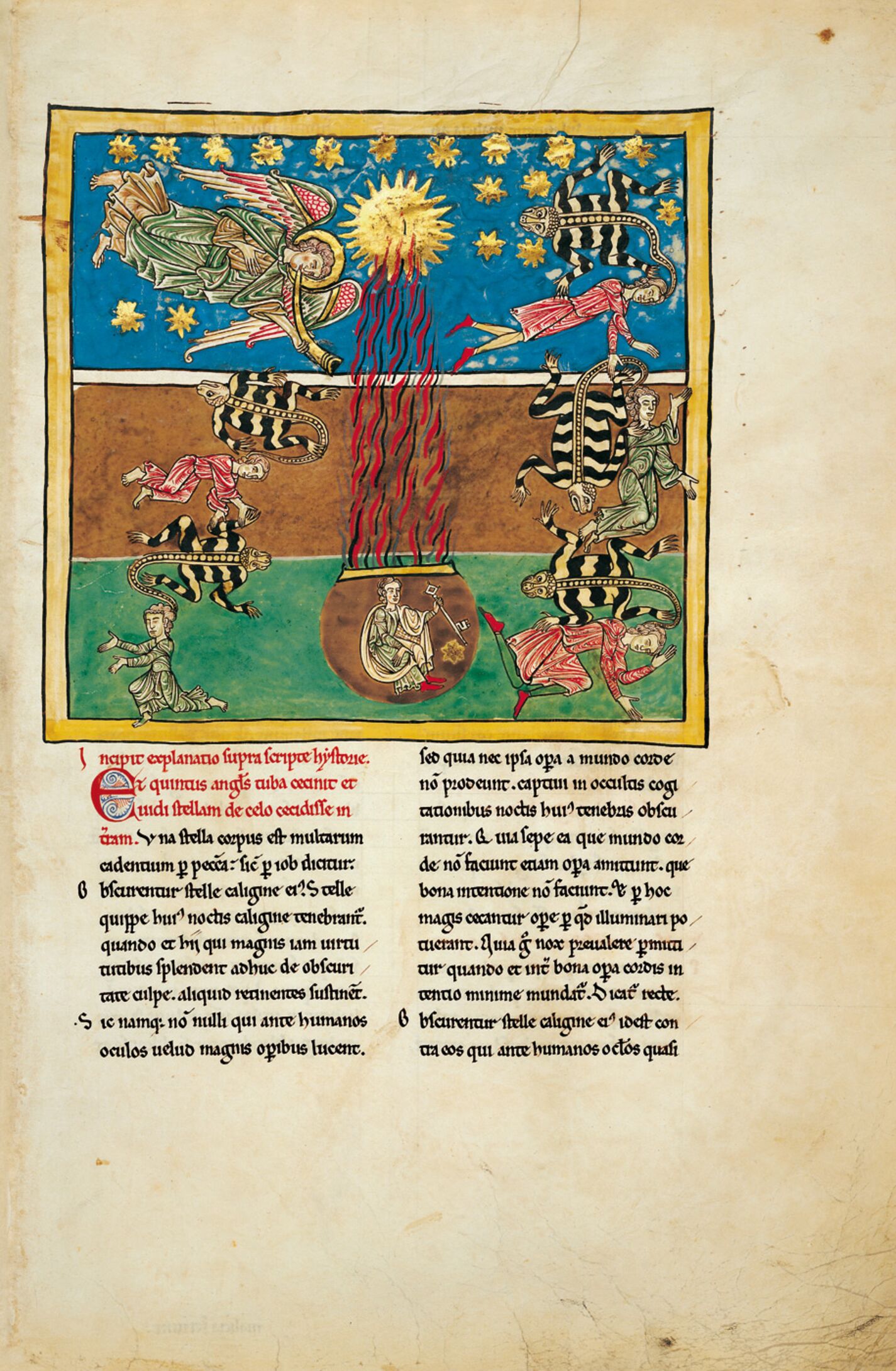The explanation of the different elements that comprise the storia is as follows: the bottomless pit is the human heart deep inside which Satan takes refuge. The smoke arising from it represents the sins committed in the world that hide the Church’s preaching. The locusts mix with the smoke and are compared in the Apocalypse with scorpions. They are depicted as lizards, becoming frogs in the San Pedro de Cardeña and the Rylands Beatus (f. 130r), with bodies striped like zebras in the former and spotted in the latter.
The Cardeña illustration is inspired by the Gerona Beatus (f. 154v) in which, unlike Magius’ Beatus and that of Valcavado, the mention ABISSUS has been eliminated. The square structure of the illustration under study is divided into three wide bands of different colours: a blue sky sprinkled with golden stars, brown and green. The green strip at the bottom contains the abyss in the form of a hollow inside which sits a figure holding a key next to a star. The figure is not winged, unlike the Lorvao codex, as if it were the angel himself sounding the trumpet. The human figures tormented by locusts that have already emerged from the bottomless pit have different, very agitated postures and are clothed in accordance with the text. Some are barefoot whilst others wear shoes. They are not naked because they are not dead. The column of smoke mingles with flames. The great star falling from the sky is golden. The Arroyo Beatus (f. 96v) features completely different conventions, evidence that it was inspired by a different source.
Ángela Franco Mata
Chief of the Medieval Antiquities Department, Museo Arqueológico Nacional
(Fragment of the Cardeña Beatus commentary volume)

The explanation of the different elements that comprise the storia is as follows: the bottomless pit is the human heart deep inside which Satan takes refuge. The smoke arising from it represents the sins committed in the world that hide the Church’s preaching. The locusts mix with the smoke and are compared in the Apocalypse with scorpions. They are depicted as lizards, becoming frogs in the San Pedro de Cardeña and the Rylands Beatus (f. 130r), with bodies striped like zebras in the former and spotted in the latter.
The Cardeña illustration is inspired by the Gerona Beatus (f. 154v) in which, unlike Magius’ Beatus and that of Valcavado, the mention ABISSUS has been eliminated. The square structure of the illustration under study is divided into three wide bands of different colours: a blue sky sprinkled with golden stars, brown and green. The green strip at the bottom contains the abyss in the form of a hollow inside which sits a figure holding a key next to a star. The figure is not winged, unlike the Lorvao codex, as if it were the angel himself sounding the trumpet. The human figures tormented by locusts that have already emerged from the bottomless pit have different, very agitated postures and are clothed in accordance with the text. Some are barefoot whilst others wear shoes. They are not naked because they are not dead. The column of smoke mingles with flames. The great star falling from the sky is golden. The Arroyo Beatus (f. 96v) features completely different conventions, evidence that it was inspired by a different source.
Ángela Franco Mata
Chief of the Medieval Antiquities Department, Museo Arqueológico Nacional
(Fragment of the Cardeña Beatus commentary volume)